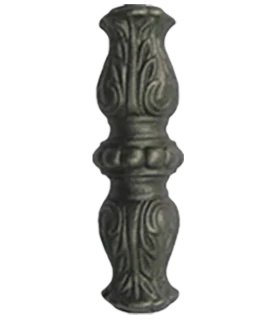Aluminum Profile Solutions for Modern Doors and Windows Design
Aluminum Profiles for Doors and Windows An Overview
The modern architectural landscape is increasingly embracing the use of aluminum profiles for doors and windows. These profiles offer a blend of strength, durability, and aesthetic appeal, making them a popular choice for both residential and commercial constructions. In this article, we will delve into the various advantages of aluminum profiles, their applications, and some considerations to keep in mind when selecting aluminum for your door and window needs.
Understanding Aluminum Profiles
Aluminum profiles are specially designed shapes that consist of aluminum alloys, extruded into different forms to meet specific construction needs. The extrusion process allows manufacturers to create a wide range of shapes and sizes, making aluminum versatile for various applications. Using aluminum for doors and windows not only enhances the structural integrity but also offers design flexibility.
Advantages of Aluminum Profiles
1. Durability One of the key benefits of aluminum profiles is their exceptional durability. Unlike traditional wood or PVC options, aluminum is resistant to warping, cracking, and fading, ensuring that doors and windows remain functional and attractive for years.
2. Low Maintenance Aluminum requires minimal upkeep compared to other materials. A straightforward cleaning routine with mild soap and water keeps aluminum doors and windows looking pristine. Furthermore, the natural oxidation process creates a protective layer that guards against corrosion.
3. Energy Efficiency Modern aluminum profiles can be equipped with thermal breaks, significantly enhancing their energy efficiency. This feature minimizes heat transfer, allowing for better temperature regulation inside buildings. As a result, homeowners can enjoy reduced energy bills and increased comfort.
4. Aesthetic Versatility Aluminum profiles can be finished in a variety of colors and textures to complement any architectural style. From sleek modern designs to traditional appearances, aluminum can accommodate an array of preferences. Its ability to be easily shaped and customized means that bespoke solutions are readily available.
5. Lightweight Despite its strength, aluminum is relatively lightweight compared to other materials. This quality simplifies the installation process, reduces transportation costs, and allows for larger openings without compromising structural integrity.
6. Sustainable Aluminum is 100% recyclable without losing its properties. Choosing aluminum profiles for doors and windows is an environmentally friendly option, as reusing aluminum can significantly reduce energy consumption and resource depletion.
Applications of Aluminum Profiles
aluminum profiles for doors and windows

Aluminum profiles are used in various applications, including
- Residential Doors and Windows Homeowners often prefer aluminum for its contemporary finish, performance, and longevity. Sliding doors, casement windows, and bi-fold doors made from aluminum create seamless indoor-outdoor transitions.
- Commercial Structures Aluminum profiles are ubiquitous in commercial construction, providing large glass facades, storefronts, and office partitions. Their lightweight nature allows for expansive designs while maintaining safety standards.
- Curtain Walls In modern architecture, aluminum profiles serve as the framework for curtain walls, which are exterior walls of a building that are non-structural and primarily serve aesthetic purposes. This application showcases aluminum’s versatility and strength.
Considerations When Choosing Aluminum Profiles
When opting for aluminum profiles for doors and windows, there are several factors to consider
- Quality of Material Ensure you choose high-grade aluminum profiles to guarantee durability and performance. Look for well-known manufacturers who adhere to industry standards.
- Thermal Performance Assess the thermal efficiency of the aluminum profiles. Options with thermal breaks or specialized coatings offer enhanced insulation.
- Design Options Explore various finishes, colors, and styles to find the best fit for your building’s aesthetics. Customization is essential for achieving a unique look.
- Budget While aluminum profiles may have a higher upfront cost compared to other materials, their long-term durability and low maintenance can result in significant savings over time.
Conclusion
In summary, aluminum profiles for doors and windows represent a robust and stylish option for modern design. Their durability, low maintenance requirements, energy efficiency, and sustainable attributes establish them as a leading choice in contemporary architecture. Whether for a residential renovation or a commercial project, aluminum profiles can enhance both the visual appeal and functionality of a building. As technology advances and design trends evolve, aluminum will undoubtedly continue to play a crucial role in shaping our built environment.
-
Wrought Iron Components: Timeless Elegance and Structural StrengthNewsJul.28,2025
-
Window Hardware Essentials: Rollers, Handles, and Locking SolutionsNewsJul.28,2025
-
Small Agricultural Processing Machines: Corn Threshers, Cassava Chippers, Grain Peelers & Chaff CuttersNewsJul.28,2025
-
Sliding Rollers: Smooth, Silent, and Built to LastNewsJul.28,2025
-
Cast Iron Stoves: Timeless Heating with Modern EfficiencyNewsJul.28,2025
-
Cast Iron Pipe and Fitting: Durable, Fire-Resistant Solutions for Plumbing and DrainageNewsJul.28,2025
-
 Wrought Iron Components: Timeless Elegance and Structural StrengthJul-28-2025Wrought Iron Components: Timeless Elegance and Structural Strength
Wrought Iron Components: Timeless Elegance and Structural StrengthJul-28-2025Wrought Iron Components: Timeless Elegance and Structural Strength -
 Window Hardware Essentials: Rollers, Handles, and Locking SolutionsJul-28-2025Window Hardware Essentials: Rollers, Handles, and Locking Solutions
Window Hardware Essentials: Rollers, Handles, and Locking SolutionsJul-28-2025Window Hardware Essentials: Rollers, Handles, and Locking Solutions -
 Small Agricultural Processing Machines: Corn Threshers, Cassava Chippers, Grain Peelers & Chaff CuttersJul-28-2025Small Agricultural Processing Machines: Corn Threshers, Cassava Chippers, Grain Peelers & Chaff Cutters
Small Agricultural Processing Machines: Corn Threshers, Cassava Chippers, Grain Peelers & Chaff CuttersJul-28-2025Small Agricultural Processing Machines: Corn Threshers, Cassava Chippers, Grain Peelers & Chaff Cutters












